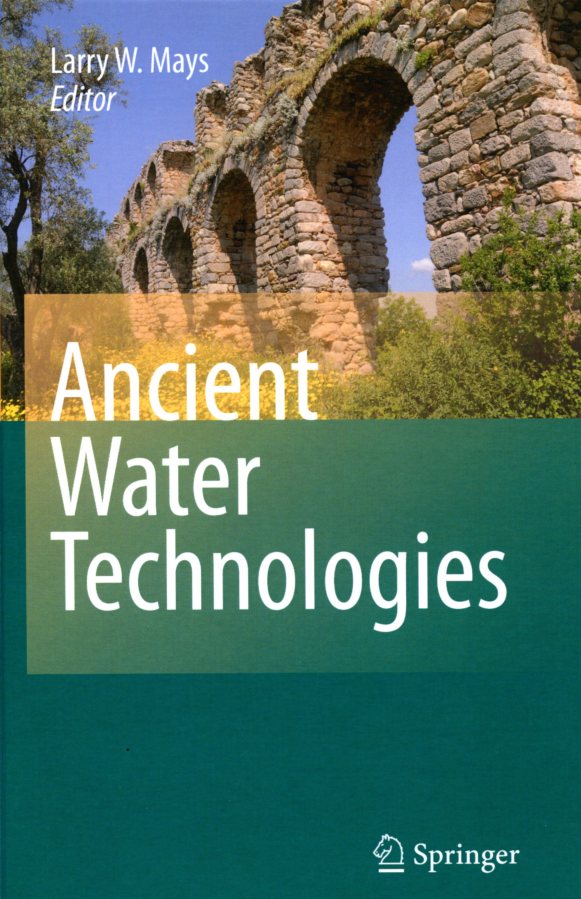Preface and Table of Contents
Ancient Water Technology
From my perspective this book has grown out of a sincere passion to learn about water technology developed by ancient civilizations. This passion has driven me to visit many ancient locations, particularly in Italy, France, Greece, Spain, and Turkey to study and photograph remains of the ancient water systems. Coupled with this passion is my interest in sustainability issues, in particular water resources sustainability, and how we may use technologies (traditional knowledge) developed by the ancients to help alleviate and solve some of our present day water resources problems.
This book is authored mainly by engineers having interests in hydraulics, hydrology, fluid mechanics, and water resources engineering with passions for understanding ancient water technologies. Co-authors also include archaeologists, architects, and a geologist with the same passion. This excellent coverage of expertise provides a unique presentation perspective somewhat different than other books that have been written on ancient water technology.
The scope of the book is to present an introduction to ancient water technology. Other books related to ancient water technology have concentrated on specific ancient civilizations such as the Romans, the Greeks, the Incas, the Mesoamericans, and others, not presenting a more universal picture of ancient water technology, as this book attempts.
Water technology began during antiquity long before the great works of such investigators such as Leonardo da Vinci (1452-1519) and Daniel Bernoulli (1700-1782). The history of water technology even began long before Archimedes (287-212 BC). Amazingly many great water projects were built, millenniums before the development of the concepts of conservation of mass, energy, and momentum used in present-day design of water projects.
Even though this book does not cover the entire spectrum of ancient water technology, it provides an excellent overview of the technologies of many ancient civilizations. These include the very earliest civilizations such as the Mesopotamians and the Indus Valley Civilization. Water technologies of civilizations such as the Mycenaeans, the Minoans, the Persians, and the Egyptians are discussed. Then water technologies of the Greeks, the Romans, the Urartians, and the Nabataeans are covered. In addition the water technologies of ancient civilizations in the Americas are discussed, including the Hohokams, the Anaszis, the Teotihuacans, the Xochicalcoans, the Mayans, the Aztecs, and the Incas.
Not only would it be impossible for any single author to cover the entire spectrum of ancient water technology, the topic would be impossible to cover in only one book. Of the eleven chapters I wrote four of the chapters and co-authored one of the chapters, Water Technology in the Ancient Societies, with Yuri Gorokhovich. The other six chapters were written by authors and co-authors with a great interest in ancient water technology. Each of these chapters presents a detailed discussion on topics such as ancient Greek Lavatories, analysis of the water system of a Roman city, effect on groundwater resources from earthquakes in antiquity, and water management of a complex in ancient Iran.
Water resources sustainability is the ability to use water in sufficient quantities and quality from the local to the global scale to meet the needs of humans and ecosystems for the present and the future to sustain life, and to protect humans from the damages brought about by natural and human-caused disasters that affect sustaining life. This is the definition I gave in the book Water Resources Sustainability (2007). The success and/or failure of the ancient civilizations depended upon their awareness and ability to work with water resources sustainability issues. Our present day future also depends upon similar issues related to water resources sustainability. Studying ancient water technologies may provide answers for our future.
A book is a companion along the pathway of learning. Have a good journey.
Larry W. Mays
Pagosa Springs, Colorado
and
Mesa, Arizona
USA
Larry W. Mays, Editor-in-Chief
Chapter
1. A Brief History of Water Technology during Antiquity: Before the Romans, Larry W. Mays
2. Water Technology in Ancient Mesopotamia, Aldo Tamburrino,
3. Water Technology in Ancient Egypt, Larry W. Mays
4. Ancient Greek Lavatories: Operation with Reused Water, Georgios P. Antoniou
5. Water Resource Management in Iran’s Ancient Persepolis Complex, Mahdi Moradi- Jalal, Siamak Arianfar, Bryan Karney and Andrew Colombo
6. A Web Based Information System for the Inspection of the Hydraulic Works in Ancient Greece, Nikos Mamassis and Demetris Koutsoyiannis
7. A Brief History of Roman Water Technology, Larry W. Mays
8. Analysis of the water system of the Roman city of Apamea, Benoît Haut and Didier Viviers
9. Water Technology in the Ancient American Societies, Larry W. Mays and Yuri Gorokhovich
10. Groundwater Resources and Earthquake Hazards: Ancient and Modern Perspectives, Yuri Gorokhovich, and Lee Ullman
11. Lessons from the Ancients on Water Resources Sustainability, Larry W. Mays


is there any link to the book especially chapter 3 about Ancient Egypt
Unfortunately not as Springer has the copyright.
Email me at mays@asu.edu and I can send some material.
Larry